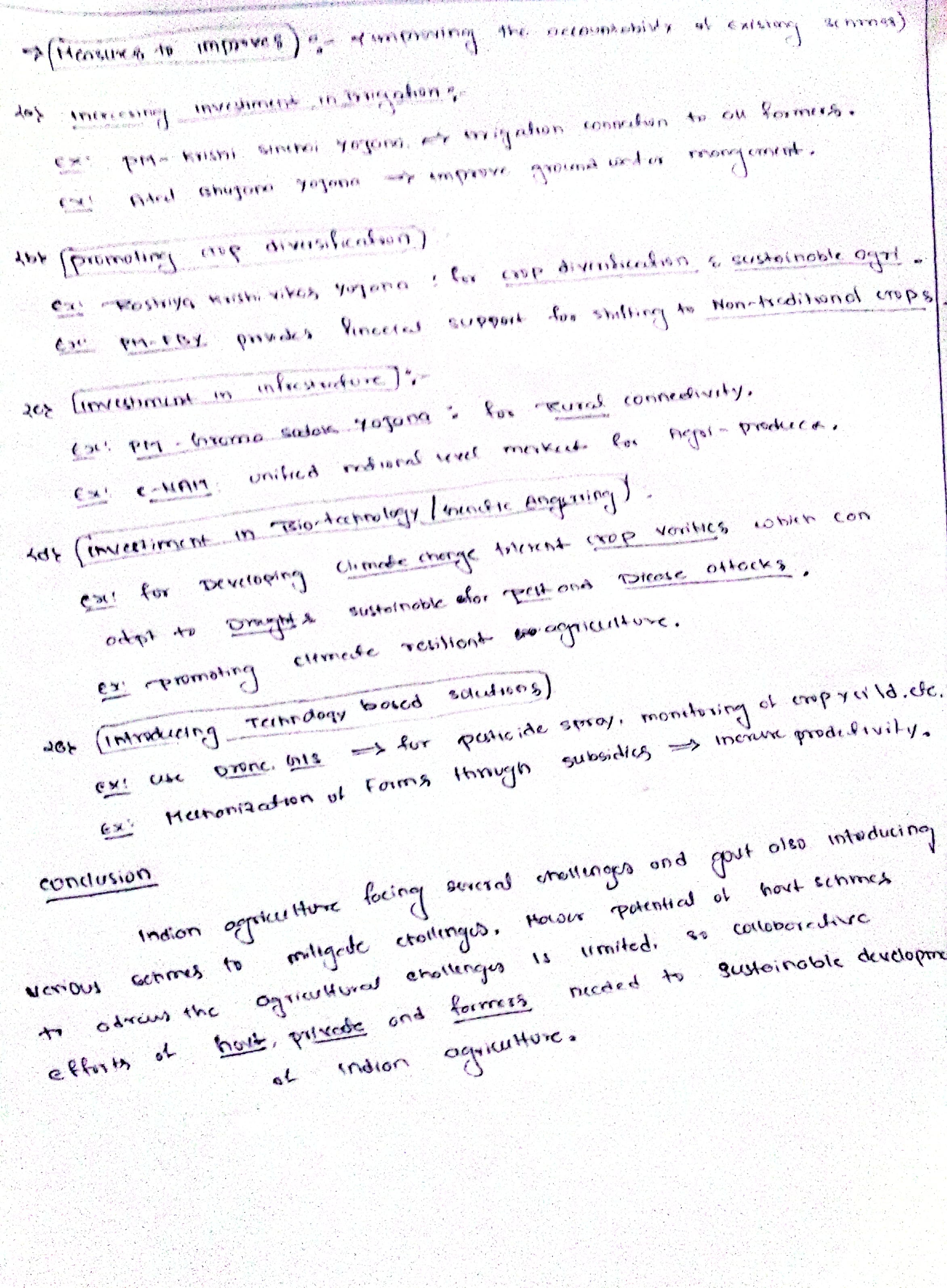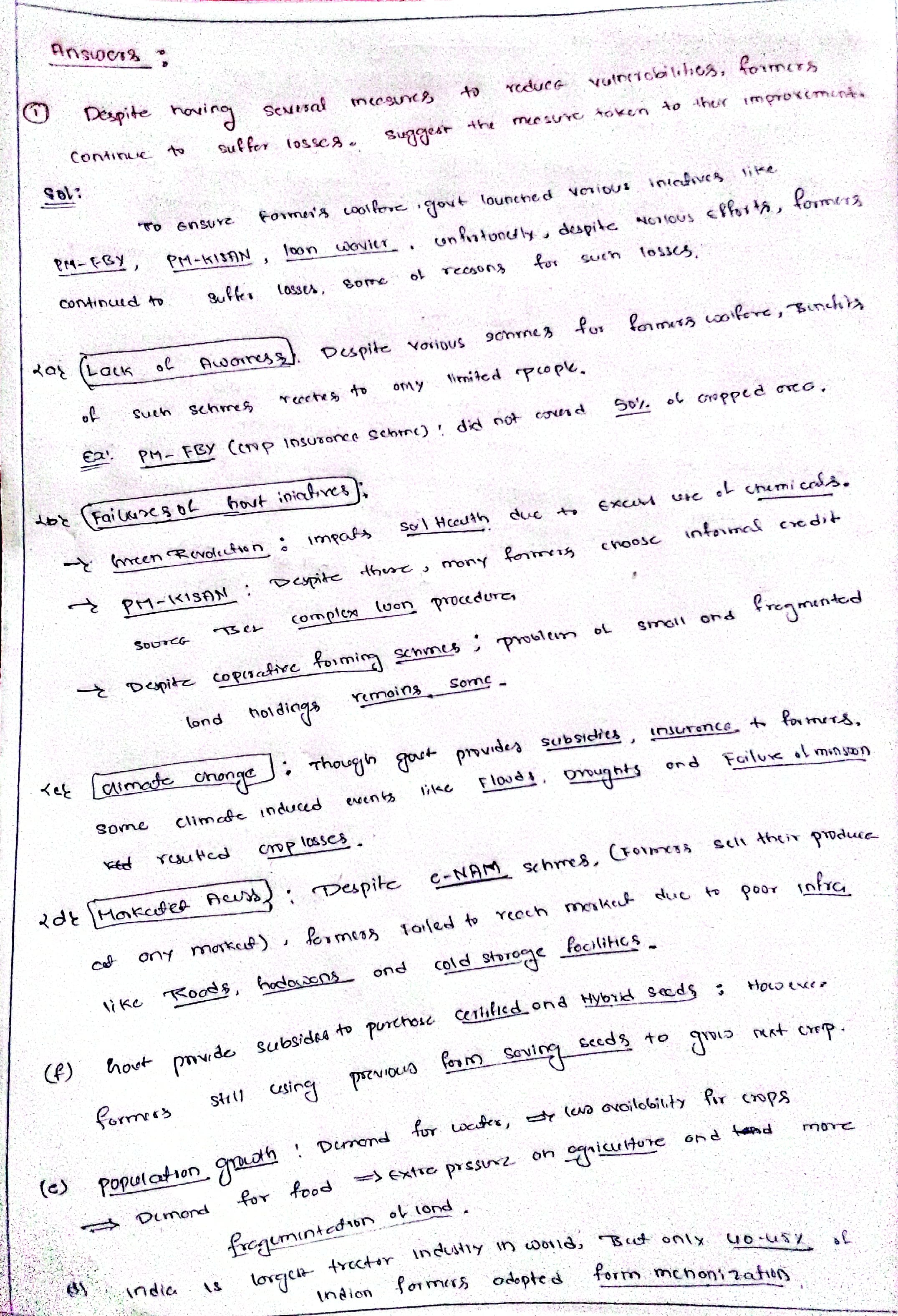| Demand of the question Introduction. Contextual introduction. Body. Discuss why farm sector and farmers continue to suffer losses? Conclusion. Way forward. |
To ensure farmers’ welfare government has launched various initiatives like Pradhan Mantri Kisan Samman Nidhi (PM-KISAN), loan waiver. Unfortunately, despite various efforts farmers continue to suffer losses. With climate change, farmers are at risk of various disasters like droughts, floods, landslides degradation that has added to farmers’ plight. Due to continued failure and acute agrarian distress farmers, face continued debt and low income trap, a condition in which farmers are mired in continuous cycle of low income and debts.
Why do the farm sector and farmers continue to suffer losses?
- Lack of Awareness: Despite various government welfare initiatives many farmers are unaware of such initiatives. Lack of knowledge hinders farmers from getting benefits from such schemes. Many farmers have never heard about direct cash transfer.
- Benefitting few: The government schemes and policies are being mostly benefitting big farmers having large landholding. Various subsidies never reach the hands of poor and small farmers. Thus, the majority of farmers are under distress and burden of debt.
- Narrow approach: The crisis of agriculture is widespread with different segments of the agricultural sector- food crops, non-food crops, and livestock economy being affected. The widespread nature of the crisis implies that any solution has to address all its dimensions. Unfortunately, the narrow approach has offered piecemeal solutions without addressing the root causes. While these may provide temporary relief to the farming community, they are unlikely to prevent another crisis a few years from now.
- Post-failure reliefs: Most of Indian policy in response to agrarian distress is based on providing subsidy or post failure reliefs in term if loan waivers. Due to continued failure and acute agrarian distress farmers, face continued debt and low income trap.
- Structural issues: Falling MSPs, leakage and wastage in transit, fluctuating prices because of global imports-exports, lack of cold storage and adequate food processing, etc. has only increased the cost of agriculture and low income profits to farmers.
- Shrinking land-holding size: Average size of landholdings have shrunk from 2.28 hectares in 1970 to 1.08 hectares in 2015 (NABARD). Fragmentation forces farmers into subsistence farming which affects their capacity to invest in land and productivity, hence perpetuating poverty. Small holding size makes the diffusion of advanced technologies difficult.
What should be done?
- Distributive Expenditure: The disparity in agriculture expenditure and growth drivers, mainly the subsidiary sectors, must be addressed. Despite higher growth in livestock and fisheries sector, only moderate to low expenditure was recorded. Expenditure on livestock and fisheries must be increased, as they are mainly connected with resource-poor families in rural areas and also to raise the decelerating growth rate.
- Strengthening FPOs: Farmer Producer Organisations (FPOs), which are currently facing operational and structural issues governed by different Acts and funded by various sources, may be strengthened by bringing them under one institution, preferably an FPO Development and Regulatory Authority.
- Affordable Technology: Affordable technologies must be developed and deployed particularly in rural and remote areas where digital literacy of farmers has improved considerably. Technology can help farmers with increased returns.
- Investment: Investment measures or an incentive-based system is essential to scale up sustainable practices such as agroforestry, climate-smart agriculture, ecosystem services, conservation agriculture and others. Increasing corporate social responsibility will help to tap more private investments besides encouraging private players in potential areas where production sustainability is possible.
- Farm data agency: The government must establish a farm data agency, which can consolidate, collate and maintain farm data available at various platforms. Ongoing efforts of digitisation of land records must also include farmer-centric advisories.
Farm sector needs more governmental efforts. Linking procurement to minimum wage, general inflation and the overall quality of living index, and freeing the farmer of loan and investment burdens, will enable elimination of agrarian distress. These measures will help achieve this faster than all the well-intentioned government policies supposed to benefit the farmers all these years.






